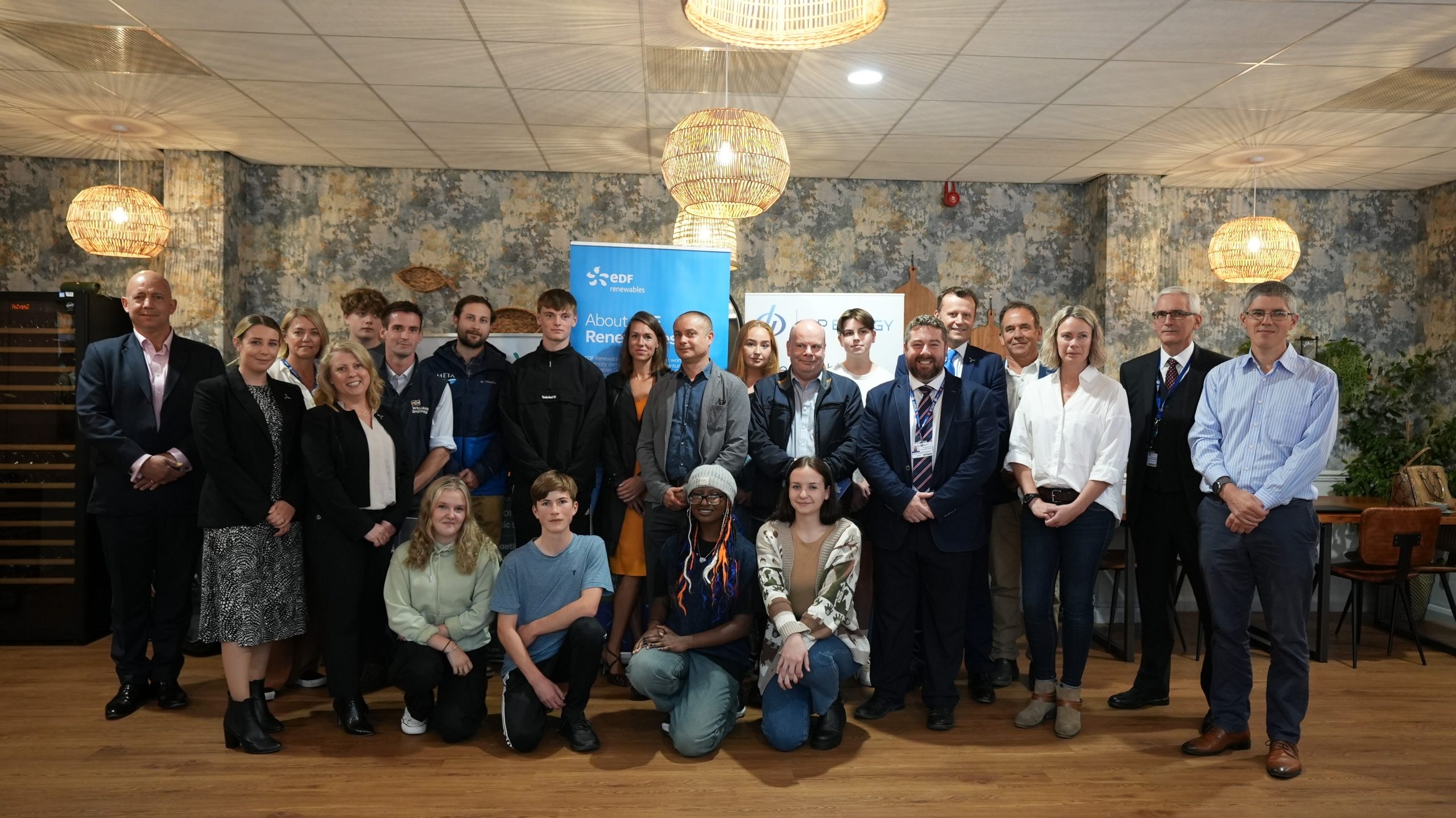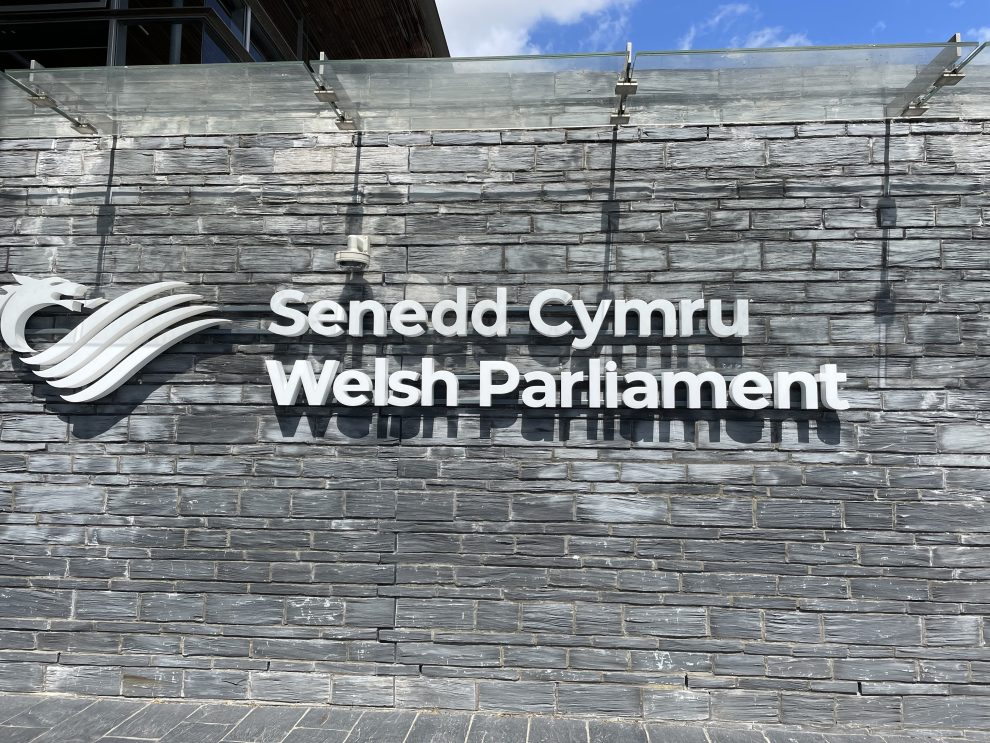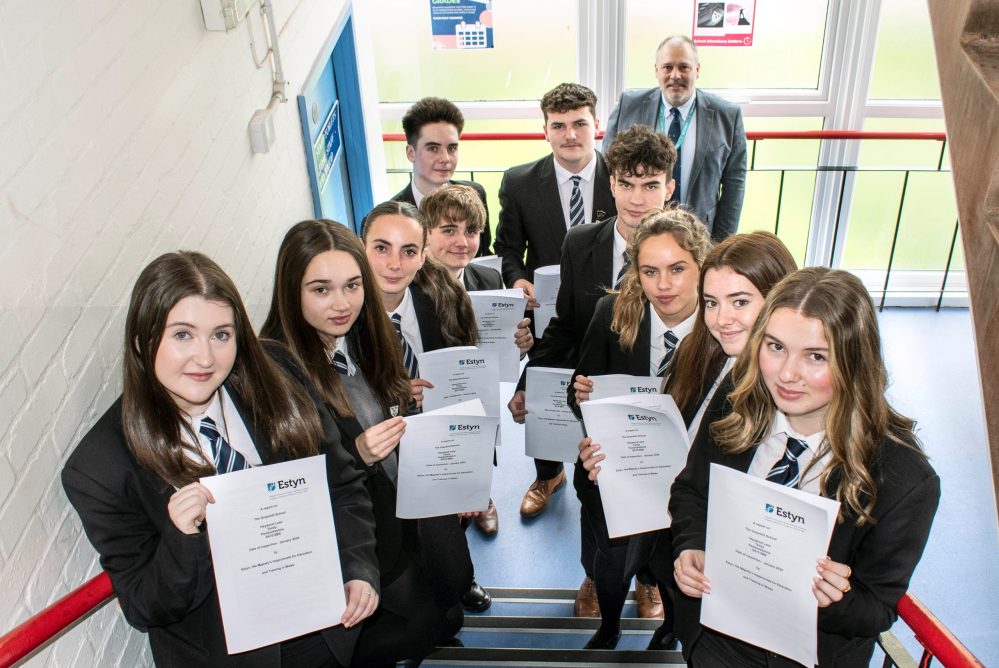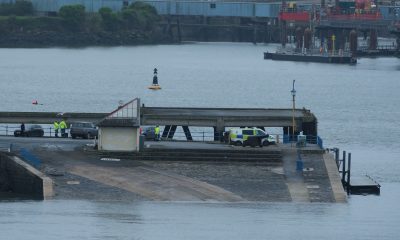Education
Students learn about offshore wind development and the jobs they could benefit from

TEENAGERS Ethan Adams and Jack Hale said they barely knew anything about renewable energy when they signed up to a brand new course at Pembrokeshire College, but that has changed.
They now have a solid grasp of what is shaping up to be a significant source of jobs and investment in the Celtic Sea – the large body of water bordered by South West Wales, the South West of England and the south of Ireland.
Floating offshore wind farms in this marine expanse could be helping the UK decarbonise its power supply further in a few years’ time, and people will be needed to assemble, install and maintain the turbines, connect them to the grid, and refine and improve their design.
Staff will also be needed to research, build and maintain tidal energy projects – like a large electricity-generating lagoon and floating solar farm that has been proposed in Swansea Bay.
Mechanical engineering students Ethan and Jack were among the first intake of a pilot course called Destination Renewables at Pembrokeshire College. The industry-led programme is the first of what is expected to be several courses underpinned by a £1.2 billion city deal for the Swansea Bay region, which comprises Pembrokeshire, Carmarthenshire, Swansea and Neath Port Talbot.
The idea of the courses will be to equip students with some of the advanced manufacturing, technical and other skills which the jobs of tomorrow will need.
Ethan, 18, of Tenby, said he was interested in widening his horizons. “I knew nothing about renewable energy,” he said. “I thought, why not expand my knowledge and gain an interest in what’s going on around me.
“I’ve really enjoyed it. I’ve found it really informative and interactive. It’s never the same thing twice.”
The students have done field trips and workshops, listened to renewable energy business leaders, and learned about the planning and consenting process, among other things.
Ethan said one example of what they’d explored was the different ways of “pegging down” offshore wind turbines, and the need to consider the impact on marine life – particular the vibrations associated with their installation.
“They were telling us that they can create a forcefield of bubbles to soak up the sound,” he said.
Ethan attended a conference held at the Port of Milford Haven where he spoke to Secretary of State for Wales David TC Davies. He and other students who have opted to carry on with the course will focus on a renewable energy project in the second year.
Ethan said he could see a future for himself in the renewable sector. “I feel like I would be quite suited to project management,” he said.
Jack, 17, who lives near Newgale, said: “I never really learned about renewable energy at school. I’ve definitely gained a wider perspective.
“We’ve had guest speakers coming in telling us about how much goes into these projects, and how many jobs there will be.”
Hayley Williams, the college’s curriculum development manager, said the course aimed to raise awareness both of the UK’s drive towards net zero – drastically cutting carbon emissions and offsetting the remainder – and the role Pembrokeshire could play in it.
Irish company DP Energy and French energy giant EDF Renewables have had a key role in delivering the pilot course.
“We started talking to DP Energy about 18 months ago,” said Mrs Williams. “What surfaced is that young people didn’t really know what net zero was and they didn’t know there was so much research and development taking place at the Milford Haven Waterway.
“The plan was to bring the whole renewable sector to life – from research and development, consenting, commissioning and connecting.”
She said around 60 students initially signed up but that this number had reduced. “Some students, say those doing doing construction, were not finding it was relevant to them,” she said. “The ones that have stayed on are thoroughly engaged. Other colleges in South West Wales are interested.”
Mrs Williams said there were around nine companies in the area developing marine energy technologies, and that a demonstration floating offshore wind project by a company called Blue Gem Wind could start being installed in the Celtic Sea next year.
Mrs Williams said she felt there was an element of “sea blindness” in Pembrokeshire about the natural resources just off the coastline. “All of a sudden it’s like somebody is opening the curtains,” she said.
DP Energy and EDF Renewables will provide mentoring opportunities to students in the second year.
Ffion Wright, of DP Energy, said: “We are working now to build on the success achieved to come back in September with a condensed programme that can be delivered to Pembrokeshire learners and rolled out to other interested colleges in Wales and the South West of England.
“A key ingredient of the programme has been the time given by industry partners to share their knowledge and expertise with students. The course fully embraces the ‘you have to see it to be it’ approach and it will continue to be central to Destination Renewables.”
UK ministers want to increase the installed capacity of offshore wind by fourfold by 2030. There are currently around 12 gigawatts (GW) of installed offshore wind in UK waters. The target is 50GW, with up to 5GW from floating rather than fixed turbines. To put it in context, the UK Government said 50GW of offshore wind would generate the equivalent electricity for approximately 75 million homes. But wind conditions aren’t perfect all the time.
DP Energy said a 1GW project it would like to develop in the Celtic Sea with EDF Renewables could generate the equivalent electricity used by 920,000 homes based on average wind yields.
All told, this would require a vast acceleration in projects coming on stream compared to now, and industry groups say the planning process needs to be shortened and environmental assessments streamlined. That in turn could concern those who worry about the impacts of offshore wind farms on busy waterways and the marine life they support.
The Welsh Affairs Committee has published a report saying that floating offshore wind, like the 1GW joint venture proposed by DP Energy and EDF Renewables, represented the “single biggest investment opportunity in Wales for decades”.
DP Energy said it hopes to secure a seabed lease for the project, called Gwnyt Glas – Welsh for blue wind – from the Crown Estate next year. The Crown Estate has identified five zones in the Celtic Sea which will be refined into potential project development areas. It expects to begin a seabed leasing tender process this year for companies looking to develop projects up to 1GW.
Meanwhile, the ports of Milford Haven and Port Talbot together form the newly-announced Celtic Freeport, which aims to speed up the roll-out of floating offshore wind among other things. Free ports have tax exemptions and aim to boost economic activity.
Another long-term project – part of the city deal programme – is the testing and development of zero-carbon marine energy in Pembrokeshire. Called Pembroke Dock Marine, the £60 million project comprises infrastructure improvements, an engineering centre of excellence, and a new test area and demonstration zone.
It appears that South West Wales could have a big part to play in solving the UK’s net zero puzzle. There will be significant upfront costs but also good job prospects for young engineers, scientists, welders and project managers.
“I think it’s definitely a big move and it will take time,” said Jack. “But, with climate change, I think it’s the way to go.”
Education
Conservative calls for academies and free schools rejected by Senedd

THE SENEDD has rejected calls to introduce free schools and academies after a report found major challenges in Wales’ education system.
Tom Giffard led a Conservative debate on educational attainment, warning that Wales is consistently at the bottom of UK-wide league tables.
The party’s new shadow education secretary pointed to an Institute for Fiscal Studies (IFS) report on education in Wales which found low outcomes and high levels of inequality.
Mr Giffard told the Senedd the IFS report highlights the pitfalls of the Welsh Government putting all its eggs in the basket of a skills-based approach.
Criticising a failure to measure skills inequalities and pupil progress, he stressed that Wales’ lower performance is due to policy and approach rather than funding or the pandemic.
He said: “It seems the Welsh Government relies on Pisa results to tell the story but then, when those same results are all too disappointing, they are dismissed in equal measure.”
Mr Giffard, who previously worked in a primary school, said declines in Pisa results can be observed in almost every country that has adopted a skills-based approach.
Raising concerns about disappointing Pisa results, the South Wales West MS pointed out that Wales saw the lowest scores in the UK for every subject.
Heledd Fychan, Plaid Cymru’s shadow education secretary, warned that Wales’ schools are understaffed and facing difficult decisions due to budgets being at breaking point.
She criticised implementation of the Welsh Government’s additional learning needs (ALN) reforms, saying schools cannot realise the aims without the budget to bring them to life.
Ms Fychan said Plaid Cymru agreed with much of the Tory motion but her party would not support calls for free schools and academies.
Sam Rowlands described the IFS report as damning, warning that the Welsh Government’s education reforms have been disastrous and have widened inequality.
The Tory MS claimed the reforms are systematically holding back disadvantaged children, saying: “The most remarkable fact is that the performance of disadvantaged children in England is either above or similar to the average for all children in Wales.”
Mr Rowlands added: “The poorest in England’s schools are doing the same or better than the Welsh average, thanks to ambition, the academies and free schools.”
Samuel Kurtz, a fellow Tory, said free schools and academies have driven up standards in England as he argued a Wales roll-out provides an opportunity to improve outcomes.
James Evans, the Conservative MS for Brecon and Radnorshire, highlighted the party’s pledge to get 5,000 more teachers into Wales’ classrooms.
Buffy Williams, the newly elected chair of the Senedd’s education committee, said Wales is undergoing a profound transformation propelled by ALN and curriculum reforms.
The Labour MS for Rhondda stressed the importance of listening to teachers and allowing ample time for the reforms to take root in classrooms across Wales.
Altaf Hussain recounted a conversation he had this week with a headteacher at one of the largest schools in his South Wales West region.
The Conservative said: “The major improvements they have been delivering to attainment and addressing behavioural issues are all at risk because of cuts to funding.
“Vital work undertaken to improve the lives of young people with additional needs could be halted because they cannot afford to continue employing the support workers.”
Lynne Neagle recognised the scale and seriousness of work still ahead to improve Wales’ education system, stressing: “I am not, in any way, complacent about that task.”
Wales’ newly appointed education secretary, who takes over from Jeremy Miles, said sustained improvement in attainment will be among her top priorities.
She told the chamber: “My early focus has been to listen closely to schools and where it is clear that schools seek more scaffolding.”
Ms Neagle said the Welsh Government will work with trade unions and employers to reduce workload and eliminate unnecessary red tape.
The Conservative motion was voted down, 14-35, following the debate on April 24. The motion as amended by the Welsh Government was agreed, 26-23.
Education
Ysgol Greenhill welcomes positive Estyn report

YSGOL Greenhill and Pembrokeshire County Council have welcomed a strong and very positive Estyn report for the school.
Estyn, the education and training inspectorate for Wales, has released its findings following a full inspection of the school, based in Tenby, carried out in January 2024.
The report noted:
- Under the supportive leadership of the Headteacher, staff at Ysgol Greenhill work together effectively to secure a happy and respectful learning community. Together they have developed a culture of openness and collaboration and share an ambitious goal to become a self-improving school.
- Leaders have secured improvements in many important areas of the school’s work, such as pupils’ learning and attitudes and the provision of care and support for pupils’ wellbeing.
- There is a suitably coordinated approach to improving pupils’ literacy, numeracy and digital skills, including support for pupils who have weak basic skills.
- Leaders seek pupils’ views regularly on the quality and suitability of its provision and make changes accordingly. This includes amendments to pupils’ learning experiences and to the provision for developing pupils’ personal and social education.
- Teachers plan their lessons well to ensure that pupils make good progress in their learning, subject knowledge and in developing relevant literacy and numeracy skills. Teaching assistants collaborate well with teachers to ensure that pupils who require support receive beneficial assistance as they work.
- The school has a broad and valuable range of provisions to support pupils’ well-being. These include individual, tailored resource centres that provide learning, behavioural and emotional support as well as a nurture centre for pupils with low attendance. The school also hosts a local authority learning centre for pupils with autistic spectrum conditions.
- The additional learning needs team work relentlessly to ensure that pupils who access these provisions are supported purposefully to enable them to make progress in their learning and social skills.
- Pupils have positive attitudes towards school and their learning. They feel safe and value the friendly and supportive nature of staff. They settle swiftly in lessons and engage well in activities. Pupils value the ‘Ready to Learn’ system which rewards positive behaviour and provides relevant support for any pupil who displays negative behaviour.
- Sixth form pupils are strong ambassadors of the school. They are friendly and polite towards visitors, conduct themselves well and are good role models for the younger pupils. Nearly all sixth form pupils say they are well supported to make progress in their academic, personal and social development. Many benefit well from valuable opportunities to lead and influence aspects of the school’s work.
- Senior prefects run the school’s numerous pupil groups, house captains and deputy captains organise and manage house activities and trained peer mentors support younger pupils with their learning and social skills. Overall, sixth form pupils develop into mature, knowledgeable young people who speak highly of the valuable experiences they have had during their time at school.
Headteacher, David Haynes said: “I am delighted and immensely proud of this report. The school has made consistent progress over recent years and I very much look forward to Ysgol Greenhill being placed amongst the best schools in Wales.

“I must pay tribute to the outstanding staff and governors who have worked relentlessly to ensure that every pupil is valued and that their wellbeing and progress in their learning has been paramount.
“Ysgol Greenhill is a school that our pupils, families and wider community can be justifiably proud of.”
Councillor Guy Woodham, Cabinet Member for Education and Welsh Language, said: “The school has made good progress in the past two years and this is reflected in the inspection report.
“The strong and dedicated leadership of the Headteacher has contributed significantly to the inspection outcome. Alongside this the contribution of the governing body and the support from the local authority has also helped the school to achieve well. I am confident the school will continue to improve and thrive.”
Chair of the Governing Body, Mrs Heulwen Lear added: “I am thrilled that the report recognises that ‘building a supportive and positive working relationship with their pupils is a strong feature of teaching at Ysgol Greenhill’. Many pupils make secure progress in their learning and subject knowledge and understanding.
“Ysgol Greenhill’s values of kindness, respect, empathy and the celebration of diversity are reflected well in its strong commitment to pupils’ personal and social development. Staff care deeply about the well-being of their pupils and are sensitive to their individual circumstances.”
The full report is available online.
Education
Milford Haven School pupils showcase artistic talent at the Torch

FROM May 3 to May 23, the Joanna Field Gallery at the Torch Theatre, Milford Haven will be exhibiting art works by pupils from Milford Haven Comprehensive School. This will be their fourth exhibition at the Torch.
The exhibition will see 44 pupils, aged 15 to 16, who undertook GCSE Art last summer taking part. Previously, the exhibition was held at the Milford Haven Town Hall before being relocated to the Torch.
“The exhibition is a celebration of art-work created by the pupils in their final year and a chance to see what they have achieved,” explained Katie George, the Art Technician at Milford Haven Comprehensive School.

Katie added: “This will be the ninth exhibition that the school has arranged. We started off in Milford Town Hall and then were very excited to be able to show our annual art event in the Torch. This will the fourth year showing in the Torch, which has been really fantastic as it gives us a chance to show the work of the pupils in a professional setting, and the pupils have spent a great deal of time and effort completing their masterpieces under the watchful eye of their Art Teacher, Mr Chris Green. They re encouraged to use as many different materials as possible ranging from painting in watercolours and acrylics, printing, sculpture, collage, clay work, printing and many more.
“The pupils work on their individual investigations. They pick a theme of their choice and then work through with artist research that connects to their theme. They then follow with lots of experimentation using different media and materials also painting, drawing and sketching. They then have their two-day exam, which they have spent time planning for using all the skills and materials they have now become familiar with to produce a final piece that will be shown in the exhibition,” explained Katie.

“It’s always exciting to tell the pupils that their final pieces will be on show in an exhibition in The Torch and generally they are excited for that to happen. They are so busy trying out new materials and ideas during their lessons, that they don’t really think about the exhibition itself until they are invited to see their work at the Torch. When they come with their parents or friends, it’s usually a real ‘Feel Good Factor’ of achievement, which is always great to see. The whole ambiance and setting created at the Torch is perfect,” concluded Katie.
To see the exhibition by pupils from Milford Haven Comprehensive School from 3 May to 23 May at the Joanna Field Gallery, Torch Theatre visit www.torchtheatre.co.uk or call by during Box Office opening hours.
-

 News7 days ago
News7 days agoPolice issue update on the search for Luke, missing from Pembroke Dock
-

 News2 days ago
News2 days agoPolice and air ambulances at ‘serious incident’ at West Wales school
-

 News6 days ago
News6 days ago20mph U-turn: Some roads will return to 30mph following public outcry
-

 Community6 days ago
Community6 days agoMiracle pup finds her forever home after heart-wrenching journey
-

 Crime2 days ago
Crime2 days agoPembrokeshire pensioner accused of 17 sexual offences against children
-

 Crime20 hours ago
Crime20 hours agoAll three school stabbing victims discharged from hospital, police confirm
-

 Community3 days ago
Community3 days agoCounty Hall to offer space for community banking
-

 Crime4 days ago
Crime4 days agoBrian Davis: Wanted on suspicion of commercial burglary























